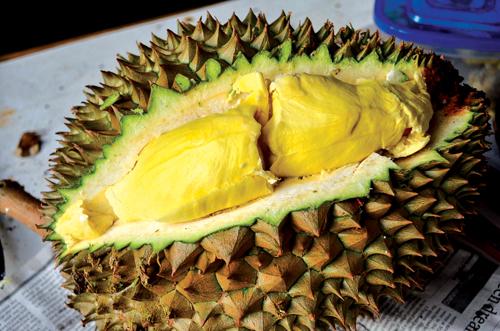Phuket Food: For the love of durian

PHUKET: As a Thai, I am fully aware of the nation’s love affair with food. But one item baffles me still and it’s no other than the infamous fruit – durian. I have observed that there was no two-way thing about this so-called king of Thai fruits – you either love it or hate it.
As the latter, I decided to see for myself what the fuss was all about and joined two durian aficionados, Wanida Hongyok and Wilaiwan Dienel, on their fruit tasting trip to Phang Nga, an activity they indulge in on almost a weekly basis during the season, which typically falls around June-August.
“Good characteristics of durian are as follows,” explained Wilaiwan to me, the uninitiated: “Creamy texture, that is firm on the outside but yielding enough, sweet of course, with not too strong of an aroma and small seeds, which make for fleshier meat.”
The nation’s favorite varieties include Mon Thong or golden pillow in Thai, Kan Yao, so-called because of its long stem, and Chanee. These are cross-breeds, first cultivated many years back, which have become popular for their smooth and creamy texture.
But Wilaiwan and Wanida, born and bred Southerners, champion the more wild version called Durian Ban. They argued that this was what durian should be like: pungent, sugary and very gooey. However, as I was a relative newcomer and they wanted to ease me in gently, they thought I should try a milder version of durian ban a breed called Salika.
There is one problem. Salika is only grown in one small area in Phang Nga and the information we received as to where to find the orchard was sketchy at best.
Nevertheless, we took our chances and one fine Sunday morning drove off in the
direction of Tai Muang, a district in Phang Nga where Salika was reportedly last seen.
Relying on street-side fruit vendors and passersby for directions, we ventured into many dirt roads to no avail. We ran into, and tasted, a few Kan Yao long stems, which I found to be a little too pungent, with an intense hint of sulfur and mushy texture. In all, not quite my type.
Another false trail led to a fruit vendor claiming to have some Salikas, but she couldn’t fool an expert like Wilaiwan who pronounced the breed Kradoom. Kradoom was milder than Kan Yao with the taste that was not too bad. Still, I was not convinced.
Our search continued and after having been sent back and forth (by kind locals who were not quite sure what we were looking for) and losing our way many times, we were about to give up. That was when we finally came across a motorcycle taxi driver who was able to lead the way to the farm in question.
At Tambon Tung Maprao village, 15 kilometers from the Tai Muang district center, Usit Keeratiwitayayuth has been farming Salika durians for more than two decades. He took us to see his patch, a smallish farm of five rai in the middle of a vast palm plantation.
The old trees there were grand and tall. Picking the fruits, Usit explained, was no easy feat and required an adroit picker who must also be a good climber. Usit supplies to vendors in Phuket who collect from the farm on a weekly basis.
Then came the glorious moment of tasting. Salika is something to behold – creamy without being too mushy; mild almost to the point of being fragrant with honey-like sweetness that lingered long on the palette.
We piled a bunch of Salikas into the back of our pick-up truck and drove away giddy with satisfaction. And that was the day I became a durian convert.
You may find Salika durians on roadside stalls in Phuket town and Chalong. They are normally priced between 80-120 baht a kilo. Durian season lasts until the end of August.
— Nanthapa Pengkasem
Latest Thailand News
Follow The Thaiger on Google News:
























